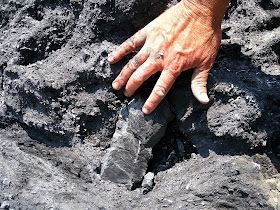I had not visited the two large landslides in 4 years (https://www.opb.org/news/article), but thought taking a new look at them was warranted for a project. I have previously posted about Canyon Creek (canyon-creek-another-path-to-reducing-a-geologic-hazard and earthfix-whatcom-countys-approach-to-landslide risk).
Geoff prepared a nice lidar view of the Jim Creek and Bald Mountain slides in the watershed using the 2017 DNR lidar - a much better resolution than what was previously available.
Bald Mountain Slide pushed out over the valley bottom of Canyon Creek
When discussing these two slides during a policy discussion, I was quoted in the newspaper as stating they "were slicker than snot".
Our venture to the slide area entailed navigating through the forested surface of the Jim Creek Slide from the Canyon Creek Road.
One of numerous fractures and slippage blocks on the slide surface
The lower part of the slide drops very steeply down to Canyon Creek.
View of the Jim Creek slide from Canyon Creek
Another section of the slide with a more recent slide shown by lack of vegetation
My last visit to the slide had been in 2014. The lower slope had greened up a bit since then with red alder trees. Prior to 2014 I had visited the slide in 2001 and 1995. In the early 2000s, there was an effort to keep the creek away from the to area of the slide. There was not a lot of that work to be seen except for a few boulders with cables that had been used to tie logs in place.
The view looking up stream shows the two slides on either side.
The trees that line the stream bank on the right are growing on a boulder levee that appears to have formed along the side of slide scarp to the right
Boulder levee
Narrow boulder levee with very large rocks
Note the large trees beginning to tilt on the slide body above the creek
Toe of the Bald Mountain Slide
Geoff checking out the pulverized rock at base of slide
The Bald Mountain Slide is within bedrock of the Bell Pass Melange. These rocks were highly deformed and sheared during tectonic emplacement. Further faulting has also taken place along a contact zone between the Bell Pass rocks and the Chuckanut Formation.
Portion of Mount Baker 1:100,000 Quadrangle (Tabor and others, 2003)
Sheared bedrock fragment from slide
Highly sheared bedrock
Both slides are underlain by rocks of the Bell Pass Melange. Tectonic shear zones in the melange are responsible for other large scale slide areas in Whatcom County.
Some more intact large boulders were present within the sheared up surrounding rock.
Bald Mountain Conglomerate
Ribbon Chert of the Elbow Lake Formation - part of the Bell Pass Melange


























